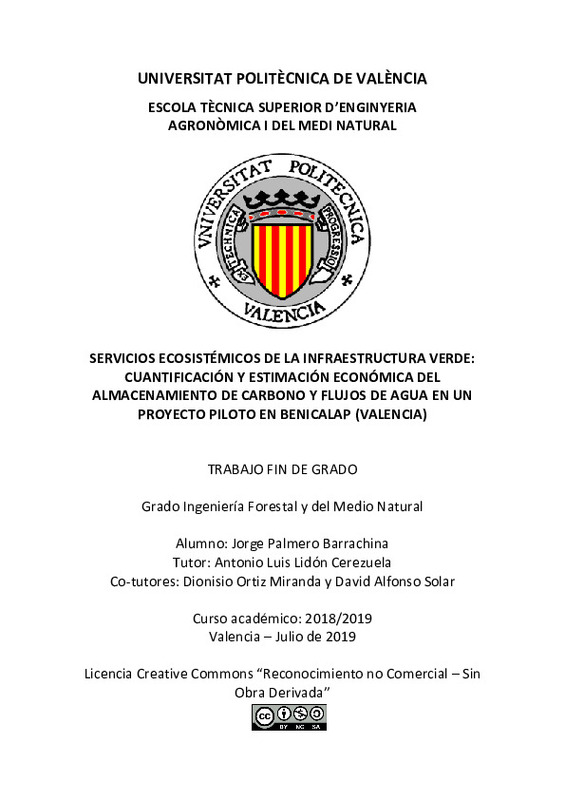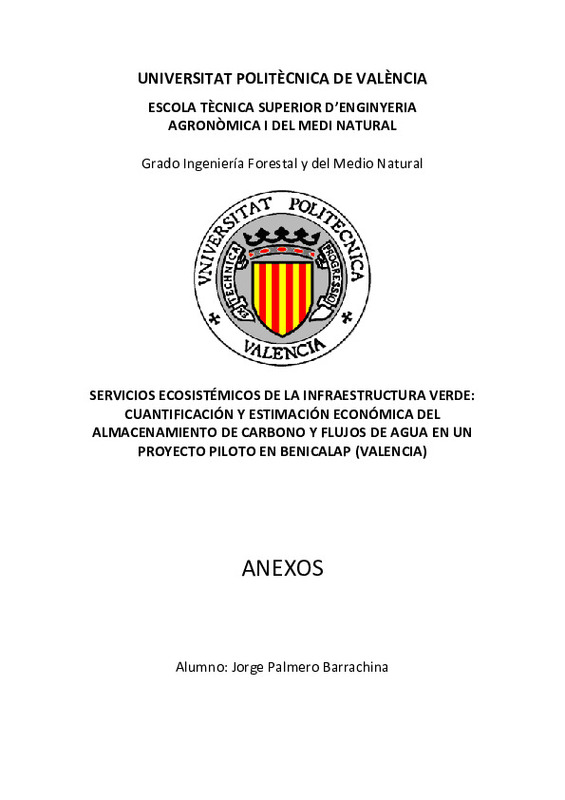|
Resumen:
|
[ES] Cada vez son más las ciudades que presentan problemas relacionados con la
meteorología, como inundaciones o estrés por calor, con proyecciones que indican que estos
problemas aumentarán debido a su continuo desarrollo ...[+]
[ES] Cada vez son más las ciudades que presentan problemas relacionados con la
meteorología, como inundaciones o estrés por calor, con proyecciones que indican que estos
problemas aumentarán debido a su continuo desarrollo y al aumento de episodios extremos en
los últimos años. Una alternativa sostenible para hacer frente a este tipo de problemática son
las llamadas soluciones basadas en la naturaleza, que tratan de incorporar la naturaleza en el
entorno urbano con el fin de proporcionar una serie de servicios ecosistémicos como la mejora
de calidad del aire, bienestar y salud de las personas, la fijación de carbono por la vegetación, la
disminución de la escorrentía superficial y otros servicios paisajísticos, creando así, una red
interconectada de zonas naturales, seminaturales y de otros elementos ambientales que reciben
el nombre de infraestructuras verdes. El diseño y la gestión de este tipo de infraestructuras
influye considerablemente en la provisión de los servicios ecosistémicos, siendo necesaria su
cuantificación y valoración.
En Valencia, más concretamente en el parque de Benicalap, se pretende crear una nueva
infraestructura verde que ayude a solventar los problemas ocasionados por las inundaciones y
el estrés por calor. En este documento se realiza una aproximación de la cantidad de carbono
acumulado y secuestrado por los árboles, así como la regulación de los flujos de agua, con el fin
de cuantificar la adicionalidad producida por el proyecto piloto sobre la situación actual.
También se valora económicamente no con el objeto de obtener un precio de mercado sino un
valor social.
El almacenamiento de carbono y la regulación de los flujos de agua se calcula con I-tree Eco v6,
que estima los crecimientos de las especies vegetales a lo largo de un periodo de treinta años
en dos escenarios: uno con las condiciones climáticas representativas de las medias de los
últimos años y otro para unas condiciones secas. Mediante un balance de agua se estima la
escorrentía, el drenaje y el agua retenida en el suelo. Una vez cuantificados los servicios
proporcionados por la parcela actual y la futura infraestructura verde, se determina la
adicionalidad producida por la intervención. Por último, para realizar una aproximación de los
beneficios económicos prestados por el proyecto piloto, se le asigna un valor a cada servicio y
se estudia su evolución en el tiempo a través del cálculo de índices generales de precios en el
mercado de las emisiones de carbono, el tratamiento de aguas residuales y del agua de riego.
Si se compara la situación actual con la intervención se pueden llegar a asimilar más de 70
toneladas de dióxido de carbono de la atmósfera, evitar más de 7.000 m3 de escorrentía y
aumentar el drenaje acumulado en más de 40.000 m3 a lo largo del periodo de treinta años
estudiados. Alcanzando así un valor de hasta 180.000 €. Sin embargo, estos valores pueden
llegar a disminuir considerablemente en función de cómo sea diseñado, gestionado y ejecutado
dicho proyecto.
[-]
[EN] Meteorological problems such as flooding, or heat stress are increasingly
growing due to the continuous development of cities and rising of problems related to pollution.
A sustainable alternative to address this ...[+]
[EN] Meteorological problems such as flooding, or heat stress are increasingly
growing due to the continuous development of cities and rising of problems related to pollution.
A sustainable alternative to address this problem is to implement nature-based solutions, which
respond to nature in the urban environment to provide ecosystem services such as improving
air quality, well-being and health of people, carbon storage, runoff avoided through the efficient
use of water and other landscape services, thus creating green infrastructures as an
interconnected network of natural, semi-natural areas and other elements.
In Valencia, more specifically in the park of Benicalap, it is necessary to create a new green
infrastructure to cushion these problems caused by floods and heat stress. This future green
infrastructure will be studied in this report, making an approximation of the amount of carbon
stored and water flows regulation, in order to quantify the additionality produced by the pilot
project on the current situation. In addition, it will be valued economically, considering that the
purpose of this valuation will not be to obtain a market price but a social value.
I-tree Eco v6 software can be used to quantify the storage carbon and the water flowsregulation
estimating the growth of the implanted trees for a period of thirty years in two stages: one with
representative weather conditions and another one with dry weather conditions. Carbon
storage and intercepted precipitation will be analysed with I-tree Eco model using the dry
biomass weight and leaf area indexes respectively. A water balance implemented in a
spreadsheet is also used to obtain runoff, drainage and water retained in the soil. Once the
services provided by the current plot and the future green infrastructure have been quantified,
the additionality produced by this intervention will be determined, thus obtaining the amount
of avoided runoff and drainage produced by the intervention of the project. Finally, considering
the economic value of each service and its evolution over time through the calculation of general
market indexes of carbon emissions, the treatment of wastewater and irrigation water, to find
an economic approximation provided by this future green infrastructure in Benicalap.
Comparing the current and future situation, depending on the type of intervention that is carried
out, more than 70 tons of carbon dioxide can be assimilated from the atmosphere, avoiding
more than 7,000 cubic meters of runoff and increasing the accumulated drainage more of 40,000
m3 over the period of thirty years studied. Thus, obtaining approximately an economic value of
180.000 €. However, these values may decrease considerably depending on how the project is
designed, managed and executed.
[-]
|








